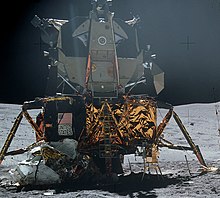Spacecraft

Spacecraft are vehicles capable of controlling their trajectory through space.
The first 'true spacecraft' is sometimes said to be Apollo Lunar Module, since this was the only crewed vehicle to have been designed for, and operated only in space; and is notable for its non-aerodynamic shape.
Propulsionedit
Spacecraft today predominantly use rockets for propulsion, but other propulsion techniques such as ion drives are becoming more common, particularly for uncrewed vehicles, and this can significantly reduce the vehicle's mass and increase its delta-v.
Launch systemsedit
Launch systems are used to carry a payload from Earth's surface into outer space.
Expendableedit
Most current spaceflight uses multi-stage expendable launch systems to reach space.
Reusableedit
The first reusable spacecraft, the X-15, was air-launched on a suborbital trajectory on 19 July 1963. The first partially reusable orbital spacecraft, the Space Shuttle, was launched by the USA on the 20th anniversary of Yuri Gagarin's flight, on 12 April 1981. During the Shuttle era, six orbiters were built, all of which flown in the atmosphere and five of which flown in space. The Enterprise was used only for approach and landing tests, launching from the back of a Boeing 747 and gliding to deadstick landings at Edwards AFB, California. The first Space Shuttle to fly into space was the Columbia, followed by the Challenger, Discovery, Atlantis, and Endeavour. The Endeavour was built to replace the Challenger, which was lost in January 1986. The Columbia broke up during reentry in February 2003.
The first automatic partially reusable spacecraft was the Buran (Snowstorm), launched by the USSR on 15 November 1988, although it made only one flight. This spaceplane was designed for a crew and strongly resembled the US Space Shuttle, although its drop-off boosters used liquid propellants and its main engines were located at the base of what would be the external tank in the American Shuttle. Lack of funding, complicated by the dissolution of the USSR, prevented any further flights of Buran.
The Space Shuttle was retired in 2011 due mainly to its old age and high cost of the program reaching over a billion dollars per flight. The Shuttle's human transport role is to be replaced by the SpaceX Dragon 2 and CST-100 in 2020s. The Shuttle's heavy cargo transport role is replaced by commercial launch vehicles.
Scaled Composites SpaceShipOne was a reusable suborbital spaceplane that carried pilots Mike Melvill and Brian Binnie on consecutive flights in 2004 to win the Ansari X Prize. The Spaceship Company has built its successor SpaceShipTwo. A fleet of SpaceShipTwos operated by Virgin Galactic planned to begin reusable private spaceflight carrying paying passengers (space tourists) in 2008, but this was delayed due to an accident in the propulsion development.
SpaceX achieved the first vertical soft landing of a re-usable orbital rocket stage on December 21, 2015, after delivering 11 Orbcomm OG-2 commercial satellites into low Earth orbit.
The first Falcon 9 second flight occurred on 30 March 2017. SpaceX now routinely recovers and reuses their first stages, with the intent of reusing fairings as well.

The X-15 pulling away from its drop launch plane

The Space Shuttle Columbia seconds after engine ignition on mission STS-1

SpaceShipOne after its flight into space, 21 June 2004

Falcon 9 Flight 20's first stage landing vertically on Landing Zone 1 in December 2015




Comments
Post a Comment